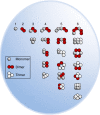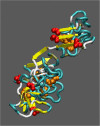Amyloid β-protein oligomers and Alzheimer's disease
- PMID: 24289820
- PMCID: PMC3978746
- DOI: 10.1186/alzrt226
Amyloid β-protein oligomers and Alzheimer's disease
Abstract
The oligomer cascade hypothesis, which states that oligomers are the initiating pathologic agents in Alzheimer's disease, has all but supplanted the amyloid cascade hypothesis, which suggested that fibers were the key etiologic agents in Alzheimer's disease. We review here the results of in vivo, in vitro and in silico studies of amyloid β-protein oligomers, and discuss important caveats that should be considered in the evaluation of these results. This article is divided into four sections that mirror the main approaches used in the field to better understand oligomers: (1) attempts to locate and examine oligomers in vivo in situ; that is, without removing these species from their environment; (2) studies involving oligomers extracted from human or animal tissues and the subsequent characterization of their properties ex vivo; (3) studies of oligomers that have been produced synthetically and studied using a reductionist approach in relatively simple in vitro biophysical systems; and (4) computational studies of oligomers in silico. These multiple orthogonal approaches have revealed much about the molecular and cell biology of amyloid β-protein. However, as informative as these approaches have been, the amyloid β-protein oligomer system remains enigmatic.
Figures


References
-
- Drzezga A, Lautenschlager N, Siebner H, Riemenschneider M, Willoch F, Minoshima S, Schwaiger M, Kurz A. Cerebral metabolic changes accompanying conversion of mild cognitive impairment into Alzheimer’s disease: a PET follow-up study. Eur J Nucl Med Mol Imaging. 2003;5:1104–1113. doi: 10.1007/s00259-003-1194-1. - DOI - PubMed
Publication types
LinkOut - more resources
Full Text Sources
Other Literature Sources

